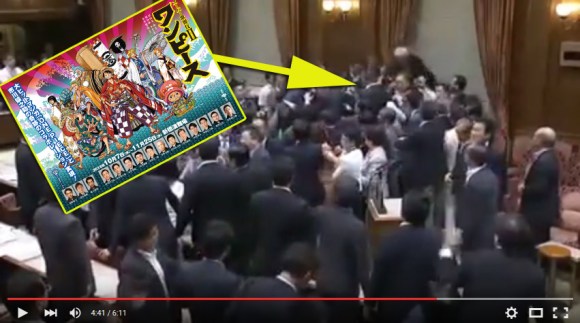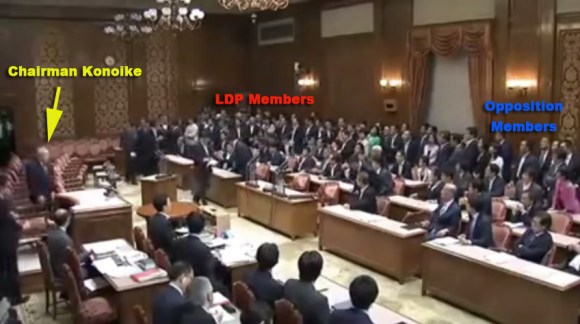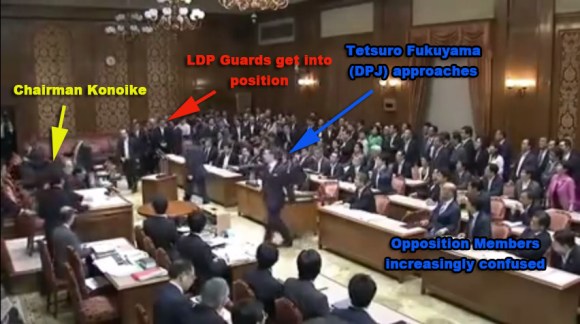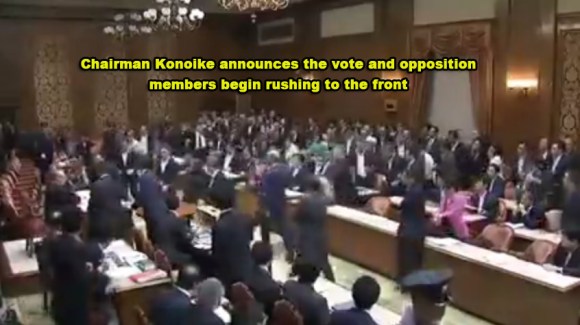
The above scene of Japanese elected officials climbing on top of each other like extras in a Pearl Jam music video made headlines worldwide much to the country’s chagrin. And it was in this way that Japan has officially reinterpreted its constitution to allow military deployment to other parts of the world for the first time since World War II.
Yes, rather than through persuasive speech and the rational debate that government was designed to produce, the future course of Japan had been steered by underhanded tricks, shoving matches, and even a decoy legislation made of a One Piece advert.
But were these uncivilized tactics motivated by honest passion and the sheer intensity of the situation, or were the elite of Japanese society simply showing their true nature of political impotence? To find out, let’s take a look at how the whole fracas started.
■ Stacked deck
Up until the events of the past week, the Japanese Diet spent over 200 hours debating the proposed changes to Japan’s policy of pacifism. After passing through the Lower House, dominated by Abe’s Liberal Democratic Party (LDP), it went for further deliberation and final approval to the Upper House, which also has a majority of LDP members.
By the numbers alone, it was a foregone conclusion that the bills would be approved. However, emboldened by large-scale protests and surveys suggesting a majority of citizens were against the bills, the opposition parties decided to take unorthodox actions to buy some time.
■ Hell no, Konoike won’t go!
On 16 September, a committee was called to discuss the security bills. However, it was widely assumed that the discussion would be concluded and voting would take place that evening to send the bills for their final vote in the Upper House. With a holiday weekend approaching, there was a high chance that protester numbers could swell greatly and weaken the LDP’s momentum.
So, in an effort to stall the vote, a group of opposition party members, made up mostly of women wearing pink headbands, picketed a room containing the committee chairman Yoshitada Konoike, trapping him inside. Since he was unable to attend, the meeting was unable to start, and so no vote occurred that night.
https://www.youtube.com/watch?v=ACGJn9OvXts
However, as Prime Minister Abe sat in the empty chamber until the wee hours of the morning arms folded and head nodding, Konoike was busy plotting his revenge…and possibly napping as well.
■ Konoike strikes back
The chairman concocted a scheme that was called “Konoike’s Coup D’Etat” by other party members. The first step was to call another session on the afternoon of Friday, 17 September. However, the purpose of this meeting was not to discuss the security bills but a motion of no-confidence against Konoike himself, which had been put forward by opposition members to further gum up the works.
Opposition party members believed this and let the committee meet, because even if they could stall the vote longer, it would still eventually return to the Lower House who could pass the bills all by themselves under what is called the “60-Day Rule.”
And so, feeling as if they had won the day, the weary opposition members showered up and got ready for another session at 4:00 p.m.
■ The stage was set
Chairman Konoike walked into the chamber and bowed to all in attendance before taking his seat. Then Democratic Party of Japan (DPJ) member Tetsuro Fukuyama began to walk towards Konoike asking what was on the agenda.
https://www.youtube.com/watch?v=jKR8PgIQl_k
Just then, about 10 or so LDP lawmakers surrounded Konoike forming a protective barrier much like an offense line around a quarterback. Opposition members stared at the formation in a brief moment of confusion until Konoike began telling them what was really about to take place.
Several opposition members ran towards the chairman’s seat in the hopes of finding some way to stop the vote from commencing. Meanwhile, LDP member Masahisa Sato who was standing near Konoike gestured to Ichita Yamamoto to start the proceedings. Yamamoto announced that deliberation for the security bills was officially closed and voting would commence immediately.
■ One Piece in the hole
All that was left was for Konoike to read aloud the bills and instructions for voting. It was determined the night before that it would take about a minute and a half, during which the LDP offensive line would have to hold back the attacking waves of opposition members to successfully start the vote.
DPJ member Hiroyuki Konishi nearly broke through by climbing over the rear of the LDP phalanx and trying to snatch the paper Konoike was reading from. However, he was easily pushed away by a slow-motion punch from Sato. Primer Minister Abe, who was sitting a few seats away, made a quiet exit once he saw the plan was working.
▼ Sato is the mustachioed gent with the slow hand
Regardless of whether Konishi could have made it to the paper, Konoike had proven himself to be a truly cunning legislator. Prior to entering the chamber he had placed a pamphlet for the kabuki adaptation of the hit manga One Piece in his pocket. In the event any opposition member could penetrate his offensive line, he could swap out the legislation with the One Piece ad and continue to open the vote.
▼ One Piece ad or constitution changing bill? Who can tell…
In the end, Konoike made it through the reading, even though no one actually could hear him over the shouting and chants of “Muko!” (Does not count!). And the security bills were moved on to an Upper House vote of 148 to 90 during a plenary session. And that’s how the future of Japan was changed.
Ultimately, history will be the judge on whether these bills were the right move or not for the country. All I know is if I were the manager of a McDonald’s and this group of politicians were my crew, they’d all have been fired on the spot.
And yet, here they are, continuing to run Japan.
Source: Asahi Shimbun Digital, Sankei News, Hachima Kiko (Japanese)
Videos & Images: YouTube/TBS News-i, YouTube/nihon1740, VINE/しーなP@Fate/Go始めました
One Piece Flyer Image: Kabuki-bito





 Japan’s Prime Minister Abe Derails Budget Meeting by Repeatedly Going to the Toilet
Japan’s Prime Minister Abe Derails Budget Meeting by Repeatedly Going to the Toilet Did Prime Minister Abe just make an entire protest disappear?
Did Prime Minister Abe just make an entire protest disappear? Japanese politician scraps plan to use Animal Crossing for political campaign tour
Japanese politician scraps plan to use Animal Crossing for political campaign tour Should Japan become the next Vegas or Macao? 57% of Japanese people say “no thanks” in new survey
Should Japan become the next Vegas or Macao? 57% of Japanese people say “no thanks” in new survey Friending Japan’s Liberal Democratic Party will get you free Shinzo Abe stamps for Line messenger
Friending Japan’s Liberal Democratic Party will get you free Shinzo Abe stamps for Line messenger Starbucks Japan ready to get Year of the Horse started with adorable drinkware and plushies【Pics】
Starbucks Japan ready to get Year of the Horse started with adorable drinkware and plushies【Pics】 Lacquerware supplier to emperor of Japan and Pokémon team up for new tableware
Lacquerware supplier to emperor of Japan and Pokémon team up for new tableware The best cosplayers from Day 1 of Summer Comiket 2023【Photos】
The best cosplayers from Day 1 of Summer Comiket 2023【Photos】 We found possibly the quietest Japanese-style hotel in Tokyo’s bustling Shinjuku district
We found possibly the quietest Japanese-style hotel in Tokyo’s bustling Shinjuku district Is the all-you-can-eat KFC buffet in Tokyo really as good as they say it is?
Is the all-you-can-eat KFC buffet in Tokyo really as good as they say it is? 7-Eleven Japan’s ramen-cooking robot whipped us up a bowl of noodles【Taste test】
7-Eleven Japan’s ramen-cooking robot whipped us up a bowl of noodles【Taste test】 Tokyo’s Tsukiji sushi neighborhood asks tour groups to stay away for the rest of the month
Tokyo’s Tsukiji sushi neighborhood asks tour groups to stay away for the rest of the month Melon bread showdown! Which Japanese convenience store melon pan is the one for you?【Taste test】
Melon bread showdown! Which Japanese convenience store melon pan is the one for you?【Taste test】 Why do Chinese characters in anime say -arimasu/-aru ALL the time?
Why do Chinese characters in anime say -arimasu/-aru ALL the time? Nagoya’s dark-red miso has continued to capture tastebuds for generations
Nagoya’s dark-red miso has continued to capture tastebuds for generations Japan may add Japanese language proficiency, lifestyle classes to permanent foreign resident requirements
Japan may add Japanese language proficiency, lifestyle classes to permanent foreign resident requirements Cyberpunk anime meets traditional culture in Ghost in the Shell gold leaf Japanese changing screens
Cyberpunk anime meets traditional culture in Ghost in the Shell gold leaf Japanese changing screens Disillusionment at Tsukiji’s tourist-target prices led us to a great ramen restaurant in Tokyo
Disillusionment at Tsukiji’s tourist-target prices led us to a great ramen restaurant in Tokyo 7 great places to see Mt. Fuji from without having to climb it
7 great places to see Mt. Fuji from without having to climb it Hello Kitty Choco Egg figures are an adorable trip through three periods of Japanese pop culture【Pics】
Hello Kitty Choco Egg figures are an adorable trip through three periods of Japanese pop culture【Pics】 Starbucks Japan releases new zodiac chilled cup drink for 2026
Starbucks Japan releases new zodiac chilled cup drink for 2026 Japan’s otoshidama tradition of giving kids money at New Year’s gets a social welfare upgrade
Japan’s otoshidama tradition of giving kids money at New Year’s gets a social welfare upgrade 7-Eleven Japan starts new temporary luggage storage service in over 300 branches
7-Eleven Japan starts new temporary luggage storage service in over 300 branches Starbucks teams up with 166-year-old Kyoto doll maker for Year of the Horse decorations【Photos】
Starbucks teams up with 166-year-old Kyoto doll maker for Year of the Horse decorations【Photos】 Tokyo considering law requiring more trash cans following litter increase in heavily touristed area
Tokyo considering law requiring more trash cans following litter increase in heavily touristed area Nintendo’s Kirby now delivering orders at Kura Sushi restaurants, but not in Japan
Nintendo’s Kirby now delivering orders at Kura Sushi restaurants, but not in Japan Tokyo event lets you travel back in time, for free, to celebrate 100 years since Showa era start
Tokyo event lets you travel back in time, for free, to celebrate 100 years since Showa era start Sanrio theme park in Japan announces plans to expand into a Sanrio resort
Sanrio theme park in Japan announces plans to expand into a Sanrio resort Stamina-destroying “Paralysis Noodles” are Tokyo’s newest over-the-top ramen innovation
Stamina-destroying “Paralysis Noodles” are Tokyo’s newest over-the-top ramen innovation Survey asks foreign tourists what bothered them in Japan, more than half gave same answer
Survey asks foreign tourists what bothered them in Japan, more than half gave same answer Japan’s human washing machines will go on sale to general public, demos to be held in Tokyo
Japan’s human washing machines will go on sale to general public, demos to be held in Tokyo Japan’s deadliest food claims more victims, but why do people keep eating it for New Year’s?
Japan’s deadliest food claims more victims, but why do people keep eating it for New Year’s? We deeply regret going into this tunnel on our walk in the mountains of Japan
We deeply regret going into this tunnel on our walk in the mountains of Japan Studio Ghibli releases Kodama forest spirits from Princess Mononoke to light up your home
Studio Ghibli releases Kodama forest spirits from Princess Mononoke to light up your home Major Japanese hotel chain says reservations via overseas booking sites may not be valid
Major Japanese hotel chain says reservations via overseas booking sites may not be valid Put sesame oil in your coffee? Japanese maker says it’s the best way to start your day【Taste test】
Put sesame oil in your coffee? Japanese maker says it’s the best way to start your day【Taste test】 No more using real katana for tourism activities, Japan’s National Police Agency says
No more using real katana for tourism activities, Japan’s National Police Agency says Starbucks Japan reveals new sakura drinkware collection, inspired by evening cherry blossoms
Starbucks Japan reveals new sakura drinkware collection, inspired by evening cherry blossoms Updated cherry blossom forecast shows extra-long sakura season for Japan this year
Updated cherry blossom forecast shows extra-long sakura season for Japan this year Japan’s prime minister asks men cheating on their wives, and their girlfriends to vote for him
Japan’s prime minister asks men cheating on their wives, and their girlfriends to vote for him Cabinet members of Japan gather to make an official position regarding PM Abe’s HaaaAUUUUnted HoooOOUUUuse!
Cabinet members of Japan gather to make an official position regarding PM Abe’s HaaaAUUUUnted HoooOOUUUuse! Survey reveals that Australian people trust Japan and Prime Minister Abe to act responsibly
Survey reveals that Australian people trust Japan and Prime Minister Abe to act responsibly Japan passes law requiring efforts for equal number of male and female candidates in elections
Japan passes law requiring efforts for equal number of male and female candidates in elections
Leave a Reply